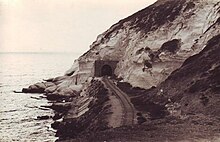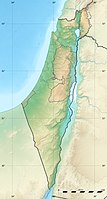 Limestone cliffs of Rosh HaNikra | ||
| Rosh HaNikra, Rosh ha-Nikra, Rosh ha-Nikra, Rosh HaNikra and others | ||
| region | West Galilee | |
|---|---|---|
| Residents | approx. 1200 (in the kibbutz) | |
| no value for residents on Wikidata: | ||
| height | unknown | |
| no value for height on Wikidata: | ||
| Tourist info web | Website for visitors | |
| no tourist info on Wikidata: | ||
| location | ||
| ||
Rosh HaNikra (Hebrew ראש הנקרה - translatable as “head of the rock cave”; Arabic رأس الناقورة Raʾs an-Nāqūra; also in many other transcriptions) is a place in Western Galilee in northern Israel, right at the end of the street 4 on the border with Lebanon.
The place is best known for its impressive white limestone cliffs and sea grottos, which were accessed by a small cable car.
background


A sandstone cliff, interspersed with dark flint in the Mediterranean Sea, ends directly at the border between northern Israel and Lebanon Access was made possible by means of a cable car.
The cliff on the border between today's Lebanon and Western Galilee was a barely passable obstacle for many historical conquerors, the army of Alexander the Great and later Muslim generals made the cliff overcome with steps carved into the rock, the rock was named "Staircase of Tire" ("Ladder of Tire").
The English mandate administration in Palestine pursued the plan of building a railway line to supply their troops along the Mediterranean coast, to overcome the section between Haifa and Beirut - Tripoli Two railway tunnels were cut into the rock in the area of the cliffs, several bridges were necessary for the railway line. With the help of thousands of Commonwealth workers and local auxiliaries, the 1943 was completed. Mainly freight trains with military supplies ran on the route, in 1944 there was an exchange between colonists of German origin from the Haifa region, who were expelled from the country due to the involvement of family members in the Wehrmacht of Nazi Germany and by Jewish refugees from concentration camps on this railway line.
In the "Night of the Bridges" in which numerous bridges in Palestine were destroyed by Jewish resistance fighters in 1946, the railway line was initially spared. Due to fears that the Lebanese army could use the route to transport soldiers and weapons to Galilee after the mandate had withdrawn, the Palmach blew up the railway bridge over the "Big Grotto" in February 1948 and interrupted the route permanently. Plans from 1947 to start passenger transport on the route were never implemented; a wall in the northern 250 m long tunnel blocks the crossing after 200 m at the level of the Lebanese border.
In the 1960s, the region around the sea caves was placed under protection and the protected area (there are sea anemones, fish, sea turtles, rarely seals and on land cliff shale) was expanded into the 1990s. A Doppelmayr cable car (A) connects the platform between the tunnels and the starting point for a tour to the grottoes carved into the rock with the car park on the street 4 in height, the journey time is two minutes.
On the northeast side of the main street 4 was founded in 1949 by former Palmach members of the Kibbutz Rosh HaNikra founded, which now operates the tourist facilities. Another economic pillar is a biotechnology laboratory, through great success in the artificial propagation of ornamental and useful plants, Rosh HaNikra has made a name for himself in banana breeding.
getting there
By plane
The nearest international airport is that of Tel Aviv, at the regional airport of Haifa only some intra-Israeli connections are processed.
By train
The railway line from Tel Aviv above Haifa ends at Nahariya, from there bus connections to Rosh HaNikraca. 6 times a day.
In the street
The access to the cable car is at the end of the main street 4which ends directly behind the parking lot and the ticket building for the aerial cableway to the rock grottoes of Rosh HaNikra on the Israeli-Lebanese border. The border known as the "Blue Line" is closed to passenger traffic; only individual UNIFIL passenger vehicles use the border crossing. Security is ensured by Israeli border guards.
By boat
There is no passenger shipping to Rosh HaNikra.
mobility
The difference in height from the road 4 at approx. 70 m and the level of the platform between the tunnels a few meters above sea level is overcome by means of a cable car, the journey is included in the entrance fee (40 NIS, 2015) On site you move on foot, only the platforms are wheelchair accessible (![]() ).
).
Tourist Attractions

.jpg/150px-Rosh_Hanikra_P1090506_(5154303892).jpg)
.jpg/220px-Rosh_Hanikra_(12276286103).jpg)
- 1 Rosh HaNikra. Tel.: 972 (0)73 2710 100, Email: [email protected]. Open: Summer 9 am-6pm, winter 9 am-4pm, FR 9 am-4pm, Saturday and public holidays 9 am-6pm.Price: 40 NIS.
- Actually, Rash HaNikra is almost exclusively visited to visit the sea caves. From the parking lot at the end of road 4, the military-guarded border crossing to Lebanon is not accessible and not passable for travelers, a short suspension railway leads to a platform located just above sea level between the two tunnels of the former British railway line. In one tunnel, a film (Hebrew, English, Russian; times are posted) provides information about the history of the place, an approx. 200 m long, non-wheelchair-accessible circular path leads mostly in tunnels to the sea caves.
activities
- Visit to the sea caves
- For a surcharge, electric vehicles can be rented from the southern tunnel exit for a tour along the coastal road.
shop
- in the area of the caves only sweets and refreshments
kitchen
- Chilled drinks, coffee and ice cream are available at kiosks / snack bars in the parking area and below on the platform between the tunnels of the former railway line.
- an upscale restaurant (1 "The Cliff", kosher) on a viewing platform in the upper area (parking lot or upper train station) was recently opened.
nightlife

In the evening, access to the caves will be closed.
accommodation
There are no overnight accommodations in the area of the caves.
Accommodation can be found in the nearby beach area a little south of the grottoes in 1 Rosh HaNikra Holiday Village.
health
Practical advice
Information is available at the ticket office at the car park or directly at the mountain station of the cable car, a brochure in English is provided.
Good cell phone coverage.
trips
- a little further south on the coastal road is the Bathing beach Betset Beach and that Nature reserve Yam Akziv Reserve.
- just a little further east, in the hills of Western Galilee, are numerous nature reserves and, among other things, the ruins of the crusader castles Montfort and Yehiam (Yudin Fortress).
- the port city well worth seeing Akko with its relics from the crusader times and the famous market is about 30 minutes to the south.
literature
Web links
- Website from Rosh Hanikra Grottos, only Heb.

